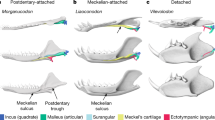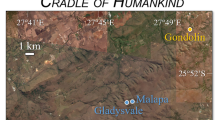Abstract
WE report here the discovery of the first ear ossicle, an incus, of a Plio–Pleistocene hominid. It is substantially different from that of modern man, and the dissimilarity exceeds that between the ear bones of Homo sapiens and of the African apes. The new incus is of interest particularly in view of the unique advantages that ear ossicles have for taxonomic and phylogenetic studies. (The only other fossil hominid ear ossicles are from Qafzeh1 and are indistinguishable from those of modern man.)
This is a preview of subscription content, access via your institution
Access options
Subscribe to this journal
Receive 51 print issues and online access
$199.00 per year
only $3.90 per issue
Buy this article
- Purchase on Springer Link
- Instant access to full article PDF
Prices may be subject to local taxes which are calculated during checkout
Similar content being viewed by others
References
Arensburg, B. & Nathan, H. L'Anthropologie 76, 301–304 (1972).
Hershkovitz, P. Living New World Monkeys (Platyrrhini) (University of Chicago Press, 1977).
Webster, D. B. Am. Zool. 6, 451–466 (1966).
Masali, M. in Taxonomy and Phylogeny of Old World Primates with References to the Origin of Man (ed. Chiarelli, B.) 69–94 (Rosenberg and Sellier, Turin, 1968).
Segall, W. Fieldiana: Zool. 51, 169–205 (1970).
Author information
Authors and Affiliations
Rights and permissions
About this article
Cite this article
RAK, Y., CLARKE, R. Ear ossicle of Australopithecus robustus. Nature 279, 62–63 (1979). https://doi.org/10.1038/279062a0
Received:
Accepted:
Issue Date:
DOI: https://doi.org/10.1038/279062a0
This article is cited by
-
Hoc alterum auditus organi ossiculum est: Ear Ossicles in Physical Anthropology
Human Evolution (2006)
-
Australopithecines: Ancestors of the African Apes?
Human Evolution (1994)
-
African ape ancestry
Human Evolution (1990)
-
Computed tomography of an Australopithecus skull (Mrs ples): A new technique
Naturwissenschaften (1989)
Comments
By submitting a comment you agree to abide by our Terms and Community Guidelines. If you find something abusive or that does not comply with our terms or guidelines please flag it as inappropriate.



